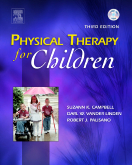|
|
|
| |
 |
|
|

|
 推薦指數:
推薦指數:





|
|
- 內容介紹
|
Physical Therapy for Children, 3rd Edition
By Suzann K. Campbell, PT, PhD, FAPTA, Robert J. Palisano, PT, ScD and Darl W. Vander Linden, PT, PhD
1200 pages 850 ills
Trim size 8 X 10 in
Copyright 2006
Description
Used as both a core textbook in PT programs and as a clinical reference, Physical Therapy for Children, 3rd Edition, provides the essential information needed by PTs, both student and professional, when working with children. Like the previous bestselling editions, the 3rd edition follows the practice pattern categories of the Guide to Physical Therapist Practice and presents evidence-based coverage of treatment in a convenient and concise format. Users will discover that the new edition features more case studies, revised chapters with additional information, a DVD-ROM with video clips, as well as a three-tiered website with resources for instructors, students, and clinicians.
Key Features
Presents broad coverage of all potential practice situations including information on unique practice settings and medicolegal information
Emphasizes an evidence-based approach that incorporates the latest research
Follows the practice pattern guidelines of the Guide to Physical Therapist Practice, 2 Edition which sets the standard for physical therapy practice
Features an entire section on the basics of pediatrics, which includes essential coverage of normal development, motor control, motor learning, and a framework for decision making
Includes extensive information on clinical management featuring practical applications for clinicians
New to this Edition
DVD-ROM featuring approximately 39 video clips that correspond to case studies and demonstrate conditions found in each chapter
More case studies providing real-world examples of the material covered in the text
Chapter on The Environment for Intervention demonstrating contextual factors that are important for children’s everyday life functions
Chapter on Genomics and Genetic Syndromes Affecting Movement that includes information on genetic resources, mutation, genetics and development, chromosomal disorders, gene disorders — providing knowledge in a growing field that has revolutionized the diagnosis and categorization for genetic disorders
Social participation aspects of the World Health Organization’s disability model explaining how rehabilitation can focus on the entire child rather than the disability
Two-color artwork highlighting important points and concepts
Table of Contents
Section I. Understanding Motor Performance in Children
Chapter 1. Evidence-Based Decision-Making in Pediatric Physical Therapy
Chapter 2. The Child's Development of Functional Movement
Chapter 3. Motor Control: Developmental Aspects of Motor Control in Skill Acquisition
Chapter 4. Motor Learning: Theories and Strategies for the Practitioner
Chapter 5. Gait: Development and Analysis
Chapter 6. Musculoskeletal Development and Adaptation
Chapter 7. Genomics and Genetic Syndromes Affecting Movement
Chapter 8. Physical Fitness during Childhood and Adolescence
Section II. Management of Musculoskeletal Impairment
Chapter 9. Juvenile Rheumatoid Arthritis
Chapter 10. Hemophilia
Chapter 11. Spinal Conditions
Chapter 12. Congenital Muscular Torticollis
Chapter 13. Arthrogryposis Multiplex Congenita
Chapter 14. Osteogenesis Imperfecta
Chapter 15. Muscular Dystrophy and Spinal Muscle Atrophy
Chapter 16. Limb Deficiencies
Chapter 17. Orthopedic Conditions
Chapter 18. Sports Injuries in Children
Section III. Management of Neurologic Impairment
Chapter 19. Developmental Coordination Disorder
Chapter 20. Children with Motor and Cognitive Impairments
Chapter 21. Cerebral Palsy
Chapter 22. Brachial Plexus Injury
Chapter 23. Spinal Cord Injury
Chapter 24. Brain Injuries: Traumatic Brain Injuries, Near Drowning, and Brain Tumors
Chapter 25. Myelodysplasia
Section IV. Management of Cardiopulmonary Conditions
Chapter 26. Children Requiring Long Term Ventilator Assistance
Chapter 27. Cystic Fibrosis
Chapter 28. Asthma: Multi-System Implications
Chapter 29. Thoracic Surgery
Section V. Special Settings and Special Considerations
Chapter 30. The Environment of Intervention
Chapter 31. Early Intervention Services
Chapter 32. The Educational Environment
Chapter 33. Assistive Technology
Chapter 34. The Burn Unit
Chapter 35. The Special Care Nursery
Chapter 36. Private Practice Pediatric Physical Therapy: A Quest for Independence and Success
Chapter 37. Medicolegal Issues in the United States
|
|
|

